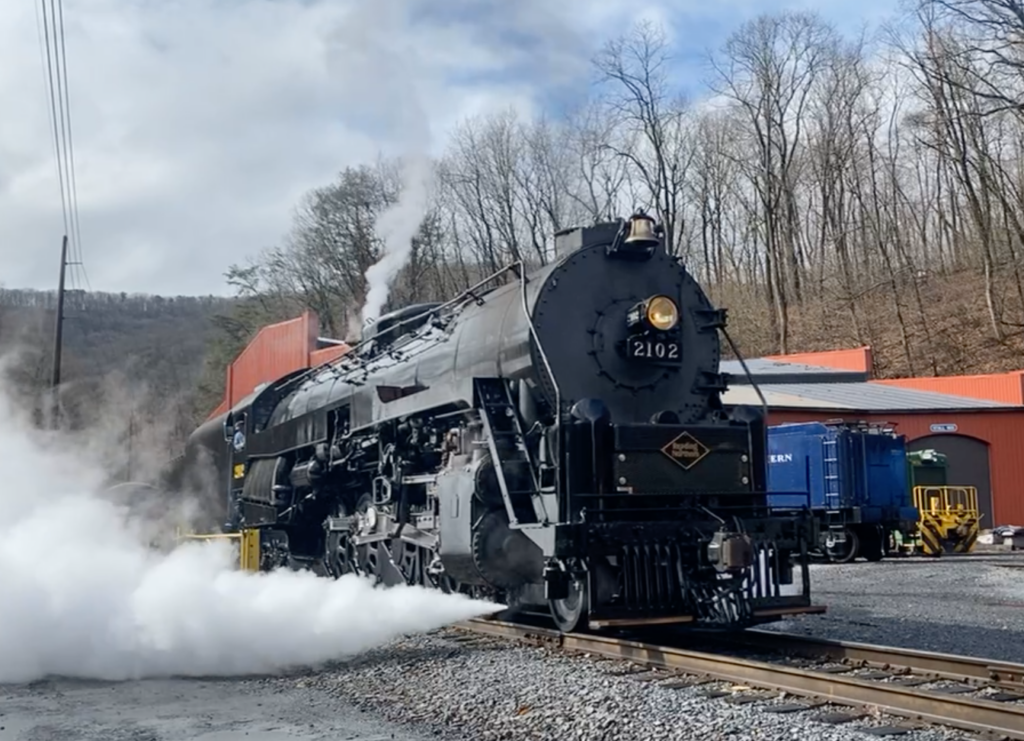Reading T-1 4-8-4 2102 is a steam locomotive of the Reading Company T-1 class locomotives built by the Reading in the 1940s. No. 2102 is expected to return to service in 2022 on passenger excursion runs in eastern Pennsylvania on lines operated by its owner on his railroad, the Reading & Northern. Periodic updates are available from the railroad.

Reading T-1 4-8-4 introduction
Bert Pennypacker wrote about Reading’s T-1 locomotives in the December 1960 issue of Trains and described their history. No. 2102 began life as Reading 2-8-0 No. 2044, a heavy Consolidation-type locomotive. The locomotives were originally built by Philadelphia’s Baldwin Locomotive Works from 1923 to 1925. They formed the I-10sa class of steam locomotives and were noted for their large size — much larger than comparable engines on other contemporary railroads.
Toward the end of World War II, the locomotives were chosen to supply boilers and parts for the planned 4-8-4 T-1 locomotives in part because of their already large size. Reading rebuilt the locomotives in their own shops in Reading, Pennsylvania, from 1945 to 1947 — among the last new mainline steam locomotives built in the United States.
Reading rebuilt No. 2102 and sister locomotives with 27-by-32-inch cylinders, 70-inch diameter driving wheels, 240-psi operating boiler pressure, and a tractive effort of 68,000-pounds. This was increased by a trailing truck booster, which originally contributed 11,100-pounds of tractive effort. The renewed locomotives weighed 441,300-pounds, much more than the original Consolidations’ 314,950-pounds of total weight.
Reading 2102 in service
Locomotive 2102 and its sister engines primarily served in all types of Reading freight service. The final 10 locomotives of the T-1 class were built with roller bearing-equipped drivers and passenger appliances, but rarely handled varnish. Pennypacker wrote in 1960 of Reading train crews using T-1 locomotives to keep up with passenger train operations and even eliminate helper service in certain locations. “This was the first (and only) completely modern, high-horsepower, high-speed freight engine Reading ever had,” Pennypacker wrote.
T-1 locomotives had varied service until Reading initially stored them 1954. They would be recalled to service a couple of times when needed. The Pennsylvania Railroad leased several in 1956 to ease it through a motive power shortage. Following retirement, No. 2102 was purchased by a steel mill to serve as a stationary steam boiler (Trains, December 1960, Page 23).
Iron Horse Rambles and the present
In 1959, Reading returned three of its remaining T-1s to service, along with the 2102, to power “Reading Rambles” of the early 1960s. No. 2102 participated in those popular excursions before being retired a second time and changing ownership multiple times until purchase by Reading & Northern owner Andrew M. Muller Jr. in the mid-1980s. Muller operated the locomotive in eastern Pennsylvania and even on Conrail trackage before long-term storage in 1991.
Today, Reading No. 2102 has undergone a thorough restoration and break-in period with the first new “Iron Horse Ramble” planned for May 28, 2022.














I should add the T-1 cylinder and driver dimensions are the same as N&W’s J’s. That said, a T-1 can’t go 100 mph as a J can, nor was a J ever rated at 12,000 tons not to exceed 150 loads from St. Clair to West Falls as was a T-1.
I always thought the logic in equipping T-1’s with steam and signal lines was to work troop trains. After WWII GI’s returning from Europe were moved by ship to North Jersey, usually Harsimus Cove on PRR. They were then shuttled to Camp Kilmer, served by PRR, RDG and LV.
An aside, 2100 was completed on or about VJ Day, September 2, 1945. She ran to Baldwin’s in Eddystone that day to be weighed.
Camp Kilmer was convenient to PRR to move troops from The Cove but not to their next destination, Indiantown Gap, North of Lebanon on RDG’s L&T Branch for separation from service.
At that time troop trains were handled by RDG’s M-1 2-8-2’s but one of those engines derailed on a troop train, blamed on excess speed and the single axle lead truck. Thus, RDG had passenger equipped T-1’s that couldn’t pull any schedulled RDG passenger train.
As to dates, 2124 pulled Rambles from 1959 to 1961. 2100 from 1960 to 1964 and 2102 from 1962 to 1964. 2102 was the T-1 that went to Carpenter Steel in Reading to supply steam in June, 1960. 2108 and 2109 had gone to a power plant in Portland PA on the DL&W in 1958 to supply steam. The engines were cleaned up and the move was publicized. It attracted so much attention RDG got the idea of the Rambles.
T-1’s worked PRR trains out of Enola and Renovo in 1956 and wrapped up their freight careers working coal and helper service out of Gordon on RDG’s Shamokin Div. in 1957.
On a few occasions, T-1’s handled military “mains,” particularly from Indiantown Gap in Pennsylvania to Camp Kilmer, NJ, during the Korean War. I know someone who was aboard one of those trains.
Also, while regular steam operations on the Reading ended in 1954, a few T-1’s were returned to service at Gordon and Rutherford in 1955, 1956 and 1957 for a few months each winter of those years. The last T-1’s were parked in early April, 1957.
Not all T-1’s were passenger equipped; only the last group, 2120 to 2129, had steam and signal lines for passenger. T-1’s were not permitted in Reading Terminal or the platform tracks at Reading Outer Station, which ruled out every schedulled R.Co. passenger train.
As far as I know, only 2126 pulled a passenger train before the Iron Horse Rambles, the middle leg from Reading to Catasauqua of a Philadelphia to Catty fantrip, going via Reading with return via Bethlehem. LV power presided over that road between Catty and Bethlehem.
2100, 2101 and 2102 have had steam and signal lines added for 1960-present fantrip service.